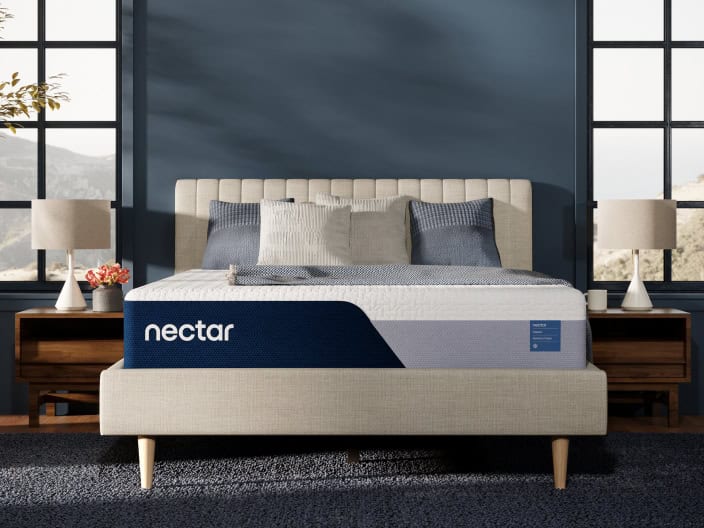What Is a Weighted Blanket & How Do They Work?
Share
Fact checked
Reviewed by experts
Updated
December 22, 2022
Quick read
9 mins to read
List of Content
Weighted blankets are nothing but heavy blankets that help relieve stress, anxiety and induce better sleep. These heavy blankets have gained a lot of popularity for all the right reasons. If you’re someone who has trouble sleeping and needs extra comfort to get a good night’s rest, this guide on weighted blankets should be useful for you.
So, let’s dive into the details of—what is a weighted blanket? How does it work? What are the benefits, and how can you choose the right weighted blanket for you?
What Is a Weighted Blanket?
Weighted blankets are therapeutic blankets that are much heavier than normal blankets. If you’ve ever found yourself wondering what are weighted blankets made of? Here’s the answer. You’ll find weighted blankets in two styles: knitted and duvet style. The knitted style blankets are woven using thick and heavy yarn, and the duvet style blankets are filled with ball bearings, plastic, glass beads, or other heavy materials.
A weighted blanket’s weight is around 5 to 30 pounds and can be used on the couch, bed, or anywhere else you would like to wind down and relax.
So that brings us to the question—what is a weighted blanket used for? The short and simple answer to that is weighted blankets are used for getting better sleep and reducing stress, anxiety, and other similar conditions.
How Do Weighted Blankets Work?
Many people wonder—how does a weighted blanket work? Imagine a warm and tight hug after a long day that melts all your tiredness away. That’s what a weighted blanket feels like.
Here’s a little science behind weighted blankets. Weighted blankets use the deep pressure stimulation technique to make a user feel more secure and comforted. Deep pressure stimulation is a gentle but firm squeezing that helps relax the nervous system. This pressure is applied with hands, massage tools, or specialized products.
The deep pressure technique was first discovered by Temple Grandin when searching for methods to ease the anxiety of autistic children. She wanted to create something that wouldn’t confine or make the children feel restricted and instead make them feel more relaxed and secure.
When done correctly, this technique triggers a reaction in the body that helps release oxytocin and creates a sense of calm and peace.
These blankets work like the “hug machine” by applying gentle pressure to the body and stimulating a release of oxytocin.
In addition to this research, a 2020 study by researchers from Florida measured the effects of weighted blankets on people. A total of 122 people participated, out of which the 61 who chose to use a weighted blanket had lower rates of anxiety than the 61 who chose not to use a weighted blanket.
20 Benefits Of Weighted Blankets
Since weighted blankets use the same technique as deep pressure therapy, their benefits are similar to this technique as well. These benefits include reduced heart rate, an increase in serotonin, and improved quality of sleep, to name a few. Let’s see what are weighted blankets good for.
1. Induces a Calming Effect
78% of people report that the warm and heavy blanket feels like a tight hug and helps them relax better. It works very well for people who tend to be hyperactive or extremely stressed out. Working professional and college students find weighted blankets to be very beneficial.
2. Reduces Sleeplessness
A weighted blanket is so heavy that it restricts your movements and, in turn, stops you from tossing and turning in your bed. Being still and calm induces sleep, so if you’re a restless sleeper, a weighted blanket should work well for you.
3. Increases Levels of Serotonin
Serotonin is the chemical in your brain that impacts and manages the sleep-wake cycle. Deep pressure therapy releases serotonin in your body and helps you sleep better. Hence weighted blankets are great for boosting serotonin levels.
4. Relieves Nervous Tension
An overly active nervous system usually goes into fight-or-flight mode and can make you feel anxious, cause hyperactivity, a rapid heart rate, and shortness of breath. By using a weighted blanket, you apply even pressure throughout your body resulting in a calming effect that helps you go into rest mode.
5. Aids with Fibromyalgia
Fibromyalgia is a condition where people experience chronic pain. People who used weighted blankets with this condition found it easier to relax at night. The blanket helps ease pain and also breaks the nerve-wracking cycle of anxiety and depression that usually comes along with this illness.
6. Reduces Heart Rate
Deep pressure therapy has a grounding effect on your body, and hence sometimes a weighted blanket is also known as a gravity blanket. A grounded effect helps lower heart rate by stopping the symptoms of anxiety or other problems that can fasten a person’s heart rate.
7. Helps in Coping with OCD
People who suffer from Obsessive-Compulsive Disorder are found to have low serotonin levels. As stated earlier, weighted blankets boost the serotonin levels in your body, resulting in calming effects. For people suffering from this condition, a weighted vest is suitable for the morning, but a weighted blanket works best to get a good night’s sleep.
8. Relieves Menopause Symptoms
When a woman goes through menopause, she typically experiences sleep disruptions, anxiety, and depression. She can combat menopause symptoms and wake up feeling more relaxed and peaceful with a weighted blanket.
9. Comforts People Suffering From Panic Disorder
Panic attacks are sudden feelings of anxiety that can cause an inability to breathe and physical pain. Weighted blankets and vests have worked well with people who get frequent episodes of panic attacks and help them live normal lives.
10. Provides a Sense of Security
When heavy blankets are covered around your body to create a swaddling effect, they provide a sense of security by providing warmth and applying gentle pressure all over your body. It literally becomes a security blanket for you.
11. Helps with Restless Leg Syndrome
Restless leg syndrome or RLS is a common condition amongst people who experience anxiety. This condition causes a rapid and involuntary movement of the legs. This involuntary movement tends to take place when you’re trying to fall asleep. However, applying pressure with the help of weighted blankets on the legs for a significant amount of time can reduce the symptoms of restless leg syndrome.
12. Helps You Wake Up Happy
When you get a goodnight’s rest, naturally, you’ll wake up feeling more relaxed, refreshed and ready to take on the world.
When people do not get proper rest, they tend to be cranky, perform poorly at school or work and feel less social. Weighted blankets can help get your life back by giving you a good night’s rest.
13. Reduces Seizures
Deep pressure stimulation has positive effects on the parasympathetic nervous system and hence can reduce the frequency of seizures. Weighted blankets can help people who experience frequent seizures as they promote comfort and overall well-being.
14. Enhances Communication Skills
Weighted blankets for kids who belong to the autistic spectrum did wonders to improve their communicative skills. The feeling of security and grounding that weighted blankets promote may have something to do with improving these skills.
15. Relaxes People with Sensory Problems
Sensory disorders are a condition that affects the processing of sensory information. Many parents find that weighted blankets are good for children with sensory disorders because of the security and comfort they provide. The therapeutic properties of a weighted blanket also help with other developmental disorders.
16. Improves Quality of Sleep
Many reports suggest that people who use weighted blankets have fewer disruptions while sleeping, often sleep longer, and have an overall improved quality of sleep. There’s a study that also stated that weighted blankets help people fall asleep faster.
17. Boosts Your Mood
Weighted blankets increase oxytocin (the feel-good hormone) and decrease the levels of cortisol (the stress hormone), which promotes an overall improvement in a person’s mood and state of mind.
18. Reduces Anxiety and Eases Stress
Experts get this question a lot—do weighted blankets help with anxiety? Yes, they do! Weighted blankets for anxiety have become more popular than ever because of their amazing effects. Stress and anxiety interfere with sleep, and a weighted blanket can help you with just that. By applying gentle pressure and warmth, weighted blankets reduce stressful and anxious thoughts.
19. Reduces Symptoms of Attention Deficit Hyperactivity Disorder (ADHD)
Children who experience ADHD find it harder to focus on the task at hand as they get easily distracted by external stimuli. By applying gentle pressure, weighted blankets can help kids with ADHD to focus and pay attention.
20. Helps People with Autism
People who have Autism Spectrum Disorder (ASD) can sometimes find it harder to interact in social situations, making them feel anxious and stressed out. The warmth and pressure of weighted blankets can help relieve their stress, sometimes even making them feel rewarded.
Who May Benefit From a Weighted Blanket?
Studies suggest that people who replaced their comforters with weighted blankets have reported improved quality of sleep. Weighted blankets can help all kinds of sleepers, but research has shown that they specifically help people with the following conditions.
People Suffering From Sleep Disorders like Insomnia
Insomnia and other sleep disorders make it harder for one to fall asleep. The added pressure of a weighted blanket can create a calming effect promoting sleepiness and making it easier for one to relax.
People Suffering From Alzheimer’s Disorder
A common symptom that comes along with this disorder is depression. Fear and fatigue can seep in for a person with Alzheimer’s disorder who is trying to make sense and remember things every day. Weighted blankets can help reduce these feelings and promote a sense of calm.
Patients of Attention Deficit Hyperactivity Disorder (ADHD)
Studies suggest that weighted blankets reduce hyperactivity and improve attention. The possible reason for this could be the gentle pressure that reminds the user of the current environment and helps them not to drift away from the task at hand.
Someone Who Has Experienced Post Traumatic Stress Disorder (PTSD)
Weighted blankets have shown positive results in people who have PTSD. Weighted blankets relax their nervous system by making them feel more grounded and secure.
People With Autism
A common symptom of autism is sleeplessness. Deep pressure therapy yields positive effects in autistic people, and these positive effects may be extended to weighted blankets as well.
Weighted Blanket: Pros & Cons
As with everything, weighted blankets, too, have pros and cons. Here are a few of them:
Pros:
- They induce a better quality of sleep
- They help relieve physical pain and improve mental health
- They release happy hormones like dopamine and serotonin
- They reduce anxiety and stress
- They provide warmth, comfort and make the user feel more secure
- They show significant improvements in people with disorders like ADHD, Alzheimer’s, Insomnia, and many others
Cons:
- They require extra care and effort for cleaning
- They are more expensive than the regular blankets and comforters
- They are too heavy and hence not travel friendly
- They can get too hot sometimes, especially in warm weathers
- They may feel uncomfortable at first
How Heavy Should a Weighted Blanket Be?
When buying a weighted blanket for adults or kids, you should ideally buy one that is 10 percent of your body weight. Here’s a table that should help:
| Body Weight | Weighted Blanket Weight |
|---|---|
| 100 lbs. | 10 lbs. |
| 150 lbs. | 15 lbs. |
| 200 lbs. | 20 lbs. |
A weighted blanket that is too heavy for your body may make you feel uncomfortable, so choose one according to your body weight.
Are Weighted Blankets Safe?
Weighted blankets are mostly safe for people who are physically able and strong enough to lift the blanket off themselves when feeling uncomfortable or suffocated.
A weighted blanket may not suit people with the following conditions:
- Chronic respiratory or circulatory issues
- Claustrophobia
- Low blood pressure
- Asthma
- Type 2 diabetes
- Obstructive Sleep Apnea (OSA)
Although there are weighted blankets for kids, toddlers and infants should not use them.
It is recommended you speak to your doctor before using a weighted blanket if you have any of the above conditions.
How To Choose a Weighted Blanket
It is recommended to choose a weighted blanket that is 10 percent of your total body weight. This, however, is not a rule set in stone. The purpose of a weighted blanket is to help you sleep better, so you should choose a weighted blanket that feels comfortable to you.
Weighted blankets weigh from 5 pounds to 30 pounds and come at different prices. This price depends on the material used and what is in a weighted blanket. The stuffing could be glass beads, plastic, or other heavy materials.
The more expensive styles and models of weighted blankets may be more durable and may have more breathability.
How To Use Weighted Blankets
Once you’ve ensured that the weighted blanket is comfortable for you, you can try out the following tips to get the most out of your weighted blanket.
- Replace your current comforter or use the weighted blanket with it. You can use both of them together or separately. It’s up to your choice!
- When using a weighted blanket, cover your entire body from shoulders to your feet for max comfort. You can use half the blanket to cover your feet in the first few days to get used to it.
- To achieve long-term benefits, use the weighted blanket consistently.
- Track your improvements or sleep cycles to know how well the weighted blanket is working.
The Final Word
Weighted blankets have wonderful effects on people who have trouble sleeping and are facing chronic conditions that cause sleeplessness. It is important to ensure that you feel comfortable using a weighted blanket. These blankets have their set of pros and cons but are extremely useful for people who have trouble sleeping.
FAQs
A good weight for a weighted blanket is the one that measures 10% of your body weight, not more than that. When you go to buy a weighted blanket, you can explore the size chart to know better.
No. Weighted weighted blankets are not hot. They are as hot as a normal blanket can be. Unlike electric blankets, weighted blankets do not have any heat setting, so they cannot generate heat.
Toddlers under the age of 2 should not use weighted blankets as it increases the risk of suffocation. Generally, weighted blankets should be used for healthy adults and children.
Although it isn’t clear that sleeping with a weighted blanket is not healthy, many sleep consultants recommend using a weighted blanket for 20-30 minutes. However, you can use it as per your needs. If you feel relaxed and comfortable, then you can use it regularly.
No. weighted blankets are great for back pain as they use therapeutic pressure to relieve back pain. Many people are using them to elevate their back and body pain.
Weighted blankets should be used by healthy people and toddlers above the age of 2. These blankets are not safe for children with epilepsy, blood circulation problems, breathing & heart issues, skin issues, or those who cannot move their blanket on their own.
If you cannot buy a weighted blanket, then you can make one for yourself.
Here are a few steps on how you can make a weighted blanket at home.
- Decide the weight of the blanket as per size and weight.
- Sew the front and back of the blanket.
- Sew vertical channels and keep an open-end for fillings.
- Fill the vertical channel with beads and weights.
- Close the open ends of the blankets properly.
This website does not offer medical advice nor professional medical services; rather, it is provided solely for educational, informational, and/or entertainment purposes. Individuals seeking medical advice should consult a licensed physician. The information provided should not be used for diagnosis or treatment of any condition, disease, or injury. When you have a medical condition, you should always talk to licensed doctor or other certified medical professional. You should never delay seeking professional medical advice or treatment based on the contents of this website. Call 911 or immediately go to the nearest emergency room if you think you may have a medical emergency. The contents of this website are provided “as-is”, Sleep Authority and its parent, subsidiaries, affiliates, employees, contributors disclaim any warranty of the information contained herein. Please contact using contact form to report any errors, omissions, misinformation, or abuse.
Sleep Authority is brought to you by Resident, the company that brings you Nectar, DreamCloud, Awara, Wovenly, Bundle, Home Well Designed and Level Sleep.





